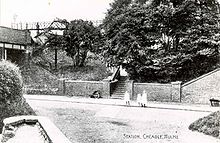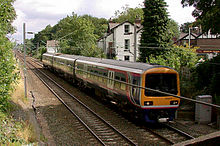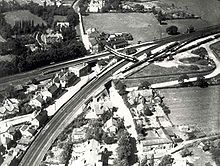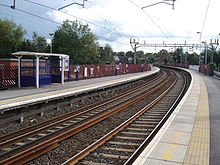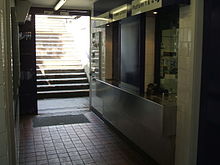- Cheadle Hulme railway station
-
Cheadle Hulme 
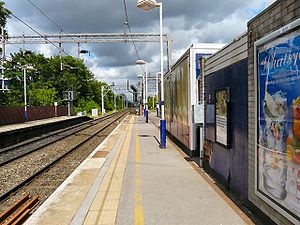
Location Place Cheadle Hulme Local authority Stockport Operations Station code CHU Managed by Northern Rail Number of platforms 4 Live arrivals/departures and station information
from National Rail EnquiriesAnnual rail passenger usage 2004/05 * 0.288 million 2005/06 *  0.357 million
0.357 million2006/07 *  0.377 million
0.377 million2007/08 *  0.424 million
0.424 million2008/09 *  0.573 million
0.573 million2009/10 *  0.552 million
0.552 millionPassenger Transport Executive PTE TfGM National Rail - UK railway stations A B C D E F G H I J K L M N O P Q R S T U V W X Y Z * Annual passenger usage based on sales of tickets in stated financial year(s) which end or originate at Cheadle Hulme from Office of Rail Regulation statistics. Please note: methodology may vary year on year. Cheadle Hulme railway station is an open triangular railway station serving Cheadle Hulme in Greater Manchester. It is located on the West Coast Main Line and is included in Network Rail Route 20 (North West Urban). The station is in Cheadle Hulme's District Centre and is operated by Northern Rail.
Cheadle Hulme's first railway station opened in 1842, when the Manchester and Birmingham Railway to Crewe was completed. With the extension of the line to Macclesfield (and later Stoke-on-Trent), a new station opened in 1845 which has served the area since. The railway had a major impact on the area, transforming it from a collection of small hamlets into a suburb of over 29,000 people.
The station remains an important part of the community, and is regularly discussed in local community meetings (known as the Cheadle Hulme Partnership). It is staffed part-time; there are no facilities other than waiting rooms and the ticket office; the closest station with more facilities is Stockport. In 2011 a major building programme was carried out, with the construction of pedestrian bridges linking all four platforms, and lifts enabling some disabled access.
Contents
History
Background
In 1833 Parliament approved the Grand Junction Railway, a railway line to connect Manchester and Birmingham.[1] It opened in 1837, after proposals had been made for more direct routes in 1830 and 1835. The earlier schemes attracted little interest, but two proposals were put forward in late 1835. The two companies, based in Manchester and Birmingham, had to negotiate with each other to develop the proposals, and they were altered somewhat over the next two years. In 1837 Parliament approved the final plans for lines to Crewe and Stoke. The companies merged to become the Manchester and Birmingham Railway company, and the first part of the line opened in June 1840. It originally ran from a temporary station at Travis Street in Manchester, to a station in Heaton Norris just north of Stockport.[2] A large viaduct was built over the River Mersey, and opened to trains on 10 May 1842. It allowed services to be extended to Sandbach; in the following August they reached Crewe. Also at this time, a new station opened to serve as the line's northern terminus; it later became Manchester Piccadilly. Edgeley railway station opened in February 1843 in response to complaints that the Heaton Norris station was "too inconvenient", and it soon became Stockport's busiest station.[3] Three years later in 1846 the Manchester and Birmingham Railway company merged with two other companies to become the London and North Western Railway.
Cheadle station
The original Cheadle Hulme railway station on the Crewe line, about 0.3 miles (0.5 km) south-west of the current structure, was known simply as "Cheadle". It was in use from May 1842, following the opening of the viaduct. The station building, opposite the Hesketh Tavern public house, is now a private residence. It included a structure from which tickets were sold, and in the window of which a candle was lit to act as a signal during the hours of darkness.[4] This structure, however, no longer exists.[5]
When plans were made for a line to Stoke-on-Trent, it was originally intended for a branch to be built from Stockport to Macclesfield. Instead, the junction was built south at Cheadle Hulme. The line was constructed over four years: it opened for goods traffic as far as Poynton in June 1845, and on 24 November it reached Macclesfield and was opened to the public.[6] In June 1846 Parliament authorised the completion of the line to Stoke-on-Trent.[7] By June 1849 the section between Congleton and Macclesfield was completed and the line was finished.[8]
New station
After the Stoke line opened, the station was rebuilt north-east at the junction so it could serve both lines. The new station opened on 9 June 1845; at first, southbound services ran to Crewe and Poynton. By November the line had been extended to Macclesfield, and by 1849, when the original station closed, it had reached Stoke-on-Trent. The new station had four platforms, and was served by trains running between Manchester and Crewe or Stoke-on-Trent.[9] It was renamed Cheadle Hulme in 1866, to avoid confusion with Cheadle LNW railway station which opened the same year.[10]
Before the arrival of the railway, Cheadle Hulme was a rural and agricultural cluster of hamlets. The railway brought a huge influx of people to the area, and provided opportunities for residents to work in places such as Manchester. Cheadle Hulme gradually grew to become a large suburb of over 29,000 people thanks to the railway.[4]
Derailments
A train derailment occurred at the station on 28 May 1964. The bridge which carried trains to Macclesfield and Stoke was in the process of being reconstructed, and trains passing over it were restricted to a temporary speed limit of 10 miles per hour (16.1 km/h).[11] A special train carrying a school party of 234 from Gnosall to York,[12] travelling on the Macclesfield line towards Manchester, took the curve at a speed in excess of the temporary restriction and several coaches derailed. Three people, including two children, were killed and 27 were injured. A hearing determined that the train's excessive speed had caused the derailment and that the train driver had been unaware of any speed limit.[11]
In July 1969, there was another derailment near Cheadle Hulme involving a freight diesel locomotive. It injured no one but blocked services to Crewe and Stoke-on-Trent for several hours.[13]
Alterations
The original station, as it remains in 2009, was sited above road level. The station office was located on the platform "island" that forms platforms 2 and 3, which were accessed by a flight of stairs where the ticket office is now. Passengers accessed the other two platforms by a footbridge, which was removed after the lines were electrified.[5] Cheadle Hulme was also used as a goods depot until 31 October 1964, when goods trains were withdrawn.[14] The goods yard is now a car park.[5]
The lines to Crewe and Stoke-on-Trent were electrified in 1960 and 1967 respectively.[10] In 1963, due to the growing amount of traffic travelling down Station Road, it was decided that the parts of the road that pass under the bridges should be widened, as they were becoming a "bottleneck". The bridge carrying the line to Stoke was upgraded first. The road under it was more than doubled in width, and the bridge height was increased by 3 feet (0.9 m) allowing double-decker buses to pass underneath.[15]
Work on the second bridge commenced on 8 June 1965, increasing the height and width in accordance with Ministry of Transport requirements. Around this time, the station itself was upgraded: the platforms were demolished and replaced, and new waiting shelters were erected. A new booking office, facing Station Road and approached by a flight of stairs, was built alongside a new booking lobby, toilets and staff accommodation. New entrances to the platforms were built, and the entire station was installed with electric lighting.[16] Station Road was significantly widened and rerouted slightly in 1967 in a further attempt to accommodate increasing traffic.[17]
Following the privatisation of British Rail, the station operation was taken over by Railtrack, and later First North Western until 2004 when it was taken over by Northern Rail. In 1996 Railtrack launched a £1 billion programme to restore and renovate every station it operated. Cheadle Hulme had £1.2 million spent on repairs to its platforms, buildings and waiting shelters, and new lighting installed throughout the station. Stephen Day, the Member of Parliament (MP) for Cheadle Hulme, opened the updated station in March 1998.[18] The junction itself was revamped in 2000 and the signal box was removed, having been superseded by a central signalling point at Stockport station.[10] In 2011, major work was carried out after years of campaigns, with the construction of pedestrian bridges connecting all four platforms, and lifts enabling disabled access to the platforms.
Services
The station's four platforms are all accessed via stairs – access to platform 1 is next to Pimlott's butchers, access to platforms 2 and 3 is through the ticket office, and access to platform 4 is near the Cheadle Hulme public house. The station and the bridges are a regular item on the agenda for local partnership meetings; for example, there are plans for the appearance of the bridges to be improved.[19] During the financial year 2007/08 passengers used the station 424,000 times, an increase of 47,000 from the previous year.[20] Northern Rail provides passenger services. Three trains per hour run northeastwards to Stockport, Heaton Chapel, Levenshulme and Manchester Piccadilly. In the other direction, trains run hourly on the Stoke line and serve stations in Bramhall, Poynton, Adlington, Prestbury, Macclesfield, Congleton, Kidsgrove, and Stoke-on-Trent. On the Crewe line, one train per hour serves Handforth, Wilmslow and Alderley Edge stations, and one train per hour serves the same stations and continues to Chelford, Goostrey, Holmes Chapel, Sandbach and Crewe.[21][22]
References
- ^ Crouzet, p.284
- ^ "A more direct way to Manchester". Virgin Trains. Archived from the original on October 16, 2006. http://web.archive.org/web/20061016093134/http://www.virgintrainsmediaroom.com/media/adobepdf/4%20Manchester%20D.pdf. Retrieved 25 May 2009.
- ^ Arrowsmith 1997, p. 168
- ^ a b Squire 1976, p. 5
- ^ a b c Garratt 1999, p. 27
- ^ Knight, p.677
- ^ Slaughter, p.25
- ^ Ingham, p.364
- ^ Reid & Lee 1979, p. 40
- ^ a b c Shannon & Hillmer 2003, p. 77
- ^ a b "Report on the Derailment that occurred on 28th May 1964 at Cheadle Hulme Station". Ministry of Transport. The Railways Archive. 30 November 1964. http://www.railwaysarchive.co.uk/documents/MoT_Cheadle1964.pdf. Retrieved 26 May 2009.
- ^ "Untitled". The Railway Magazine (IPC Media): ix. July 1995.
- ^ "Train is derailed". Stockport Express (Guardian Media Group). 17 July 1969.
- ^ "B.R. refuse council request". Stockport County Express (Guardian Media Group). 25 October 1964.
- ^ "The Cheadle Hulme rail disaster". Stockport Advertiser (Guardian Media Group). 4 June 1964.
- ^ "Early start on railway station transformation". Stockport Advertiser (Guardian Media Group). 27 May 1965.
- ^ Lee 1967, p. 4
- ^ "Platform for the future". Stockport District Advertiser (Guardian Media Group). 6 March 1998.
- ^ "Cheadle Hulme District Centre Action Plan Review 2008". Stockport Metropolitan Borough Council. http://www.stockport.gov.uk/services/business/regeneration/districtcentres/cheadlehulme/cheadlehulmeactionp. Retrieved 30 May 2009.
- ^ "2007/08 station usage". Office of Rail Regulation. 20 April 2009. http://www.rail-reg.gov.uk/upload/xls/station_usage_0708.xls. Retrieved 24 May 2009.
- ^ "Train times Manchester to Crewe via Stockport and via Manchester Airport". Northern Rail. 17 May 2009. http://www.northernrail.org/pdfs/timetables/20090427/18.pdf. Retrieved 30 May 2009.
- ^ "Train times Manchester to Stoke-on-Trent via Macclesfield". Northern Rail. 17 May 2009. http://www.northernrail.org/pdfs/timetables/20090427/19.pdf. Retrieved 30 May 2009.
Bibliography
- Arrowsmith, Peter (1997). Stockport: A History. SMBC. ISBN 0-905164-99-7.
- Crouzet, François (1982). The Victorian economy. Routledge. ISBN 0-416-31110-5.
- Garratt, Morris (1999). Pictures and Postcards from the Past: Cheadle Hulme. Sigma Leisure. ISBN 1-85058-674-8.
- Ingham, Alfred (2003). Cheshire: Its Traditions and History. Kessinger Publishing. ISBN 0-7661-5506-4.
- Knight, Charles (1851). Penny cyclopaedia of the Society for the diffusion of useful knowledge. Society for the Diffusion of Useful Knowledge.
- Lee, Ben (December 1967). A History of Cheadle Hulme and its Methodism. Trustees, Cheadle Hulme Methodist Church.
- Reid, T. D. W.; Lee, Irene (1979). Cheadle in 1851. Stockport Libraries. ISBN 0-905164-00-8.
- Shannon, Paul; Hillmer, John (2003). British Railways Past and Present No 40 Cheshire. Past and Present Publishing Ltd. ISBN 1-85895-232-8.
- Slaughter, Mihill (1849). Railway intelligence. W.H.Smith & Son.
- Squire, Carol (January 1976). Cheadle Hulme: A Brief History. Recreation and Culture Division, Metropolitan Borough of Stockport.
External links
Coordinates: 53°22′35″N 2°11′16″W / 53.3763°N 2.18778°W
Preceding station  National Rail
National RailFollowing station Northern Rail Northern Rail Categories:- Railway stations in Stockport
- Former London and North Western Railway stations
- Railway stations opened in 1845
- Railway stations served by Northern Rail
- DfT Category D stations
Wikimedia Foundation. 2010.

